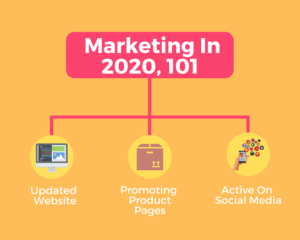
Vital Marketing & Advertising Tips For Manufacturers
Throughout the history of the world, there have been many economic downturns. Before this year’s pandemic, the most recent financial crisis in the U.S. was in 2008, brought on by subprime mortgages. But during both, the American people found a way to rise above and come out on the other side. We thought it would be helpful to provide key advertising tips for manufacturers.
As marketers, we have the difficult job of helping our clients stay afloat through this time. We do this by:
Staying Active On Social Media
Being Positive
Creating Resources For Their Clients and Customers
Forming Innovative Plans and Campaigns
One industry that is feeling a unique pain from COVID-19 is manufacturing. Historically, this industry has been strong and survived many different obstacles. But this new pandemic is bringing new issues businesses have never faced before. In a recent survey, the number of manufacturers that reported being impacted by the pandemic increased by over 40% from March to April and many have seen a decrease in demand for their products and services. This decline has caused some to take an innovative approach and shift their products to focus on critical items to help fight the coronavirus. As these companies are pivoting their businesses to stay open, it is more important now than ever to have a strong marketing front.
For companies to survive this time, they must not wait for the demand for their previous products to come back but should shift to carrying items that are in demand currently, including:
Steel
Hand Sanitizer
Automation Equipment
Packaging
Plastic Bags
But just as important as pivoting the items they produce, manufacturers must also know how to adjust their marketing to reach the new audience of potential clients they need.
Ways to do this:
Updating Websites
Writing Blogs About Their New Focus
Creating and Circulating Product Pages
Refining Email Marketing Strategy
Being More Active On Social Media Platforms
Promoting Content For Their New Audience
Collaborative Webinars
Google Ads
In the 21st century, buyers are not using magazines or posters to find new products they need, they are searching the web — That is why it is so critical that manufacturers are taking advantage of digital marketing in today’s environment. Online marketing is the most effective way to communicate products and services to a target audience.
In our last blog, we talk about how COVID-19 was affecting events, and because of that, we have seen a rise in webinars. For manufacturers and B2B companies, this impacts them greatly as their previous marketing strategies often included tradeshows and in-person events where they had opportunities to put their products in front of their potential buyers. As events continue to go virtual, it creates a new challenge for companies to know how to make meaningful connections and keep them — the key is online advertising and marketing.
Online marketing strategies must adjust to each company, but the basics are the same. You must create an extensive presence during the economic environment we are currently facing. This allows buyers to find suppliers when they are ready to source the service or product they need. Having original content available for them is vital, along with information to inform them of exactly what you are offering and how.
According to Thomas, “It has been reported that 77% of consumers were convinced to purchase a product or service based on a video, which is just one of the many reasons why manufacturers are creating more videos.”
Tools To Help You Make Videos:
RawShorts
Typito
Promo
Renderforest
Animoto
Animaker
Powtoon
Biteable
Kapwing
Example of an explainer video we made using RawShorts.
SEO Is Vital
If your SEO is low on your website, potential clients may not be able to find you, making you lose out on business. Here are tips to help:
-
- Make Google Happy – Google has its own goals and they are frequently updated. Create content that Google wants to show because it will be helpful to its user.
- Keyword Research – If your goal is to rank for keywords then you need to know which keywords are being searched for and have a plan for which pages are trying to rank for which keywords. What are people searching for related to your product or industry? Are there commonly asked questions that appear as search results? Are people looking for recommendations or tips on related content? Are there a few similarly themed questions that you’re able to answer in a blog post? Many of the keywords you’ll try to rank for depending on the website’s traffic & domain authority. Try UberSuggest by Neil Patel.
- Become a Topic Expert – For instance, you could pay a lawyer to write a blog post about “What is SEO?”, but they are likely to miss some important points, nuances and “isms” that make the content click with an audience that is looking to learn SEO. Further, having some credentials behind your name is likely to give your content even more validity and help you build trust with your audience.
- Take a Multichannel Approach – Now, there are only so many hours in a day and not everyone can afford a team that circulates content around the clock. But there are some tips we can pick up from Gary Vee’s content marketing strategy:
-
-
- Reduce – dense content out into bite-size chunks to be marketed across multiple channels.
- Repurpose – Effective content marketing doesn’t mean having to create fresh content every single day (or, even, every week).
- Instead, you can use the same outline for a single piece of content to create content for different platforms.
- Recycle – Breath life into your old content by giving it a revamp and sharing it with a new audience. Perhaps you have an old blog article that was popular when it first went life, but it got buried deep in your blog. Upcycle it with new information and share it on social media to drive new traffic to your site.
-
- Utilize Content Optimization Tools – For SEO professionals, we highly recommend tools like Grammarly, ContentRow, and CoSchedule’s Headline Analyzer to ensure that your content is user-friendly, engaging, and click-worthy.
- Competitors (SEO/social) – Use tools like SEMrush and SocialInsider to check up on what your competitors are doing and to generate ideas to stay ahead. Alexa and WhatRunsWhere. Signup for competitor e-newsletters.
- Site Speed – Most people will not wait more than 3 seconds for your site to load. So making sure your website is performing at top speed by using the Google website speed tool.
- Security Certificates – A website security certificate is also known as an SSL certificate. It allows you to display the padlock in the web address bar. This shows your customers your site is secure while also protecting your business from hackers.
- Mobile-optimized – Today it is very important to have your website accessible on mobile devices. Around 2 billion people currently access the internet via only their smartphone.
- Website Audits – Do monthly audits on your website to make sure that it is up to trends, working correctly and your SEO is in good standing. 2020 Design and brand trends have drastically changed. Google Search Console will provide reports or tools like MOZ, SEMRush, WhatRunsWhere.
- Trending Topics – Since the nature of a trend is that it tends to be short-lived, you may not generate long-term traffic through this approach, but you can see a surge in traffic overnight. Consider that “Taylor Swift” was trending (according to Google Trends) right around the time that her new documentary dropped. You can also plugin certain potential headlines to see what other topics are generated or use UberSuggest.
- Blogging –
- Create captive headlines – Use a headline analyzer and generator tools. Be sure to exclude clickbait. Tools we suggest are content row and Emotional Marketing Value Headline Analyzer.
- The longer the better – Posts should be a minimum of 1000 words but preferably 2000+. Link to multiple, high-quality sources and provide data.
- Use trendy visuals and infographics – Google’s updated algorithm is looking for amazing visuals such as videos or infographics. Try to include one media file for every 350 words.
- Submit to Google – Submit your blog post to Google to index by adding it to your site map.
- Clean house – Remove blog posts from your blog that are too short – these can actually hurt your SEO.
- Update – Blogs that have performed well in the past can be revamped to help improve your SEO. Try updating resources, facts or stats and media files.
We have been able to help many manufacturing companies through this difficult time along with our various other clients. If you would like to set up a meeting with CEO, Valerie Jennings, to see how we could help your company through this time please reach out to her personal email: valerie@jsmm-vbm.com





